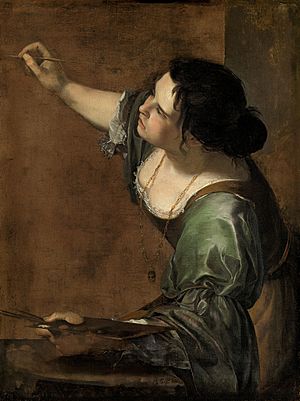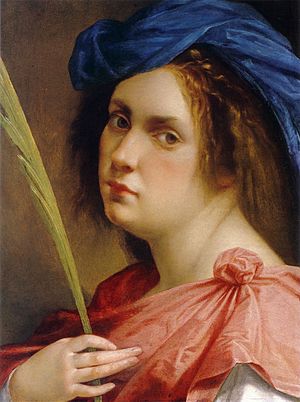Artemisia Gentileschi facts for kids
Quick facts for kids
Artemisia Gentileschi
|
|
|---|---|

Self-Portrait as the Allegory of Painting, 1638–39
|
|
| Born | 8 July 1593 |
| Died | c. 1656 |
| Nationality | Italian |
| Known for | Painting |
|
Notable work
|
|
| Style | Baroque |
| Movement | Accademia delle Arti del Disegno |
| Patron(s) |
|

Artemisia Gentileschi (born July 8, 1593 – died around 1656) was a famous Italian painter. She lived during the Baroque period, a time known for dramatic and emotional art. Artemisia started painting professionally when she was only 15 years old!
She is known as one of the most talented artists of her time. Back then, it was very hard for women to become professional artists. But Artemisia broke barriers. She was the first woman to join the Accademia delle Arti del Disegno (Academy of Arts of Drawing) in Florence. She also had customers from all over the world.
Contents
Biography
Early Life and Learning to Paint
Artemisia Gentileschi was born in Rome, Italy, on July 8, 1593. Her father, Orazio Gentileschi, was also a painter. Artemisia was the oldest of his children.
Her mother passed away in 1605. After that, Artemisia was mostly raised by her father. She learned to paint in his workshop. Artemisia showed much more interest and skill than her brothers. She quickly learned how to draw, mix colors, and paint beautiful pictures. By the time she was 18, her father was very proud. He said she was unmatched, even though she had only been painting for three years.
Artemisia's early paintings were inspired by her father's style. Her father's work was influenced by another famous painter, Caravaggio. Artemisia, however, painted things in a very realistic way. Her father's paintings were more idealized.
Her earliest painting that we still have today is Susanna and the Elders. She painted it in 1610 when she was 17. This painting shows a story from the Bible. It proves that Artemisia could use the realistic style of Caravaggio. She also used the classical style of other artists like Annibale Carracci.
Life in Florence (1612–1620)
Artemisia's father arranged for her to marry Pierantonio Stiattesi, an artist from Florence. Soon after, they moved to Florence. She spent six important years there. These years changed both her family life and her career.
In Florence, Artemisia became a very successful court painter. This means she painted for important people like the House of Medici, a powerful ruling family. She became a big part of the city's art scene.
Her career really took off in Florence. She was the first woman to be accepted into the Accademia delle Arti del Disegno. She also became friends with other respected artists. Important people like Cosimo II de' Medici, Grand Duke of Tuscany, and his mother, Christina of Lorraine, supported her. She even knew the famous scientist Galileo Galilei. A letter she wrote to him in 1635 shows their connection. This friendship might have inspired her painting Allegory of Inclination, which shows a compass.
Being part of the court in Florence helped her a lot. She met many important people who bought her art. It also helped her learn more. She learned to read and write. She also got to experience music and theater.
One important person who noticed her was Michelangelo Buonarroti the Younger. He was a younger relative of the famous Michelangelo. He was building a house to celebrate his great uncle. He asked Artemisia and other artists to paint pictures for the ceiling. Artemisia was asked to paint an Allegory of Inclination. She was paid three times more than any other artist for this work! Artemisia painted a young woman holding a compass. Many people believe the woman in the painting looks like Artemisia herself. In many of her paintings, her strong female characters seem to be self-portraits.
Other important paintings from this time include The Conversion of the Magdalene and Self-Portrait as a Lute Player. She also painted Judith and her Maidservant. Artemisia painted several versions of the story of Judith Beheading Holofernes. She was very interested in this subject.
While in Florence, Artemisia and Pierantonio had five children. Sadly, only one of them lived to be an adult.
Return to Rome (1620–1626/7)
It can be hard to know the exact dates of all her paintings. But some works are known to be from her time back in Rome. These include a Portrait of a Gonfaloniere (a type of official). This painting shows she was also good at painting portraits.
Another work from this time is Judith and her Maidservant. This painting is famous for how well she used light and shadow. This technique is called chiaroscuro and tenebrism. Many artists in Rome were known for these skills.
Life in Naples (1630–1656)
In 1630, Artemisia moved to Naples. She stayed there for the rest of her painting career.
In Naples, Artemisia painted for a cathedral for the first time. These paintings were about Saint Januarius in the amphitheater of Pozzuoli. During her first years in Naples, she also painted The Birth of Saint John the Baptist and Corisca and the Satyr. These paintings show that Artemisia could paint many different subjects. She wasn't just limited to her usual themes like Judith, Susanna, or Bathsheba. Many of her paintings from this time were collaborations with other artists. For example, Bathsheba was painted with other artists.
People used to think Artemisia died in 1652 or 1653. But new information shows she was still taking painting jobs in 1654. Some people think she might have died in a terrible plague that hit Naples in 1656. This plague wiped out many artists in the city.
Some other works from this period include Susanna and the Elders (1622), Virgin and Child with a Rosary, and two versions of Bathsheba.
Artistic Importance
Artemisia Gentileschi was known for painting women in a very realistic way. She was also skilled at using color to create depth and drama in her art.
Today, she is seen as one of the most advanced and expressive painters of her generation. Her talent is recognized with major art shows in famous places like the National Gallery in London.
Images for kids
-
Salome with the Head of Saint John the Baptist, c. 1610–1615, Budapest
-
Annunciation, 1630, Museo di Capodimonte
-
Lot and His Daughters, 1635–1638, Toledo Museum of Art
See also
 In Spanish: Artemisia Gentileschi para niños
In Spanish: Artemisia Gentileschi para niños







